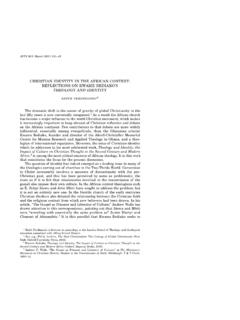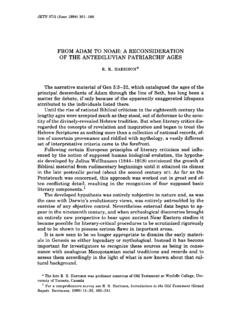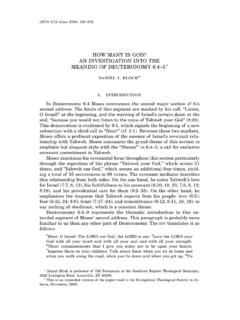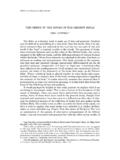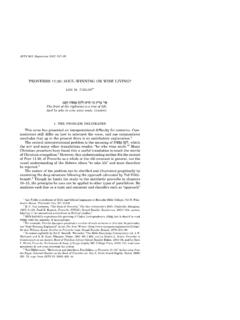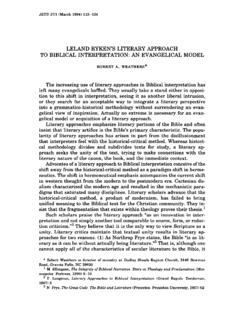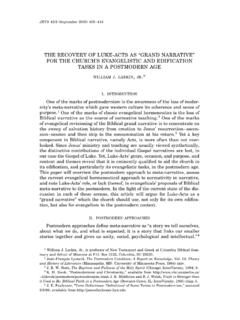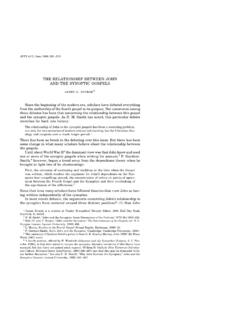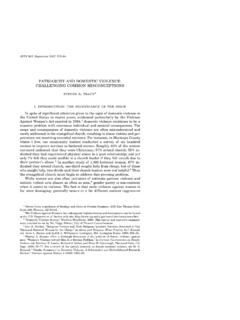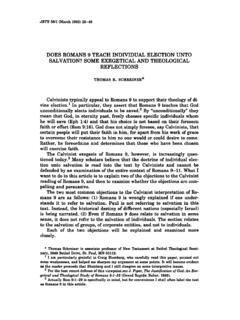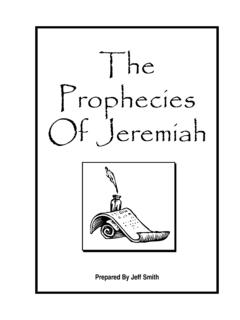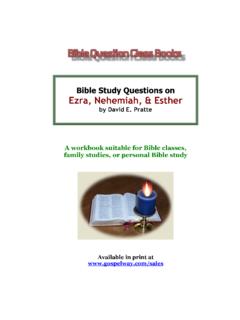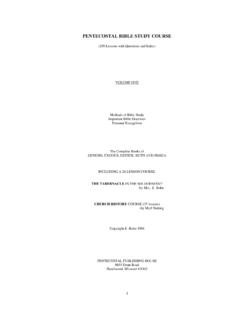Transcription of THE ORDER OF THE BOOKS IN THE HEBREW BIBLE …
1 JETS 51/4 (December 2008) 673 88 THE ORDER OF THE BOOKS IN THE HEBREW BIBLE greg goswell* The BIBLE as a literary work is made up of text and paratext. Paratextmay be defined as everything in a text other than the words, that is to say,those elements that are adjoined to the text but are not part of the textitself if the text is limited strictly to the words. The paratext of Scrip-ture embraces features such as the ORDER of the biblical BOOKS , the namesassigned to the different BOOKS , and the differing schemes of textual divisionwithin the BOOKS . 1 Since these elements are adjoined to the text, they have aninfluence on reading and interpretation. This study proceeds on the assump-tion that text and paratext (though conceptually differentiated) are for allpractical purposes inseparable and have an important interrelationshipthat influences the reading process.
2 I will examine one paratextual feature,namely, the ORDER of the placement of the BOOKS that make up the HebrewBible. Where a biblical book is placed relative to other BOOKS influences,initially at least, a reader s view of the book, raising expectations regardingthe contents of the book. 2 A reader naturally assumes that material that isjuxtaposed is in some way related in meaning. It is this habit that forms thebasis of the following survey and would perhaps be helpful at this early juncture to explain what I amnot doing in the present study. This is not a history of the formation of thecanon of Scripture. There are many BOOKS and articles that attempt such asurvey. Some of these have been used in the present study, though theirresearch and conclusions have been put to a different use than that of plot-ting the historical genesis of the collection of BOOKS that now makes up theHebrew BIBLE .
3 This article is not an effort to justify the limits of the canon, nordoes it seek to explain why some BOOKS were included ( Esther, Ecclesi-astes) or some excluded ( Sirach) from the canon of Scripture. Nor is itan explanation of the genesis of alternative arrangements of the biblicalbooks. I am not concerned with genetics but with the effect on the reader of 1 This is what an earlier scholar, C. D. Ginsburg, called the outer form of the text, as opposedto the text itself. See Introduction to the Massoretico-Critical Edition of the HEBREW BIBLE (London: Trinitarian BIBLE Society, 1897; New York: Ktav, 1966) 1, 144. Ginsburg does not, how-ever, deal with the question of the titles given to the biblical BOOKS . For an introduction to para-textual issues in general, see G rard Genette, Paratexts: Thresholds of Interpretation (trans.)
4 JaneE. Lewin; Cambridge: Cambridge University Press, 1997). 2 John H. Sailhamer calls this feature con-textuality ( Introduction to Old Testament Theology:A Canonical Approach [Grand Rapids: Zondervan, 1995] 213). * Greg Goswell is lecturer in biblical studies at Presbyterian Theological College, 684 Elgar Road,Box Hill North, VIC 3129, Australia. journal of the evangelical theological society 674the present arrangement of biblical BOOKS , however that arrangement mayhave been produced. I will seek to tease out hermeneutical implications ofthe canonical orders settled upon by different communities of faith. The aimis not to justify and promote a particular ORDER of BOOKS , whether Jewish orChristian, as the exclusive basis for further study and thinking on the mean-ing of the biblical text.
5 It is not necessary to decide upon any particular orderof BOOKS , favouring it over other contending orders, for differing orders high-light different features of the BOOKS thus categorized, so that each ORDER inits own way may be valid and useful to the reader. i. classifying book orders The ordering of BOOKS can be classified according to a number of prin-ciples. These principles need not be mutually exclusive but one may reinforceanother, and there may be more than one possible principle reflected in aparticular ORDER . Unless stated by the author or editor, it is left to the readerto surmise what rationale is at work in the ordering of the literary blocks thatmake up a larger whole. It is not necessary to know or decide how delibera-tive the process of ordering was, 3 for the focus of this study is the effect on thereader of the ORDER , not its historical production.
6 4 It is not my aim to second-guess what was in the mind of those responsible for the ordering of the bib-lical BOOKS . The following are some possible principles of ORDER as inferredby the reader after an examination of the biblical material:(1)Size of the book, the sequence: Jeremiah, Ezekiel, Isaiah, and Bookof the Twelve (= Minor Prophets) in the Babylonian Talmud ( B. Bat. 14b) may be arranged according to decreasing book length.(2) Chronological setting, Ruth 1:1 ( In the days when the judgesruled ) would seem to explain the lxx placement of this book follow-ing Judges, seeing that it is set in the same era of Israelite history.(3)Common authorship, either stated or assumed, Jeremiah-Lamentations in the lxx , though the text of Lamentations does notexplicitly name Jeremiah as its author.
7 (4)Storyline thread ( Joshua Kings), with successive BOOKS narratingwhat happened next, remembering, however, that it is the next sig-nificant thing that happened which is featured, not just the next thing,given the necessarily selective nature of narrative.(5) Genre, the bringing together of different BOOKS into a propheticcorpus, and the collecting together of Wisdom BOOKS (though a con-vincing definition of what is wisdom is notoriously difficult). 3 As noted by Sailhamer ( Introduction to Old Testament Theology 214), con-textuality does notneed to posit an intentional relative positioning of BOOKS . 4 For this reason we put to one side considerations such as the historical ORDER of composition(if that could be discovered) or the history of the canonical acceptance of BOOKS , the second beingthe postulated basis of H.
8 E. Ryle s influential explanation of the tripartite HEBREW canon. See The Canon of the Old Testament: An Essay on the Gradual Growth and Formation of the HebrewCanon of Scripture (London: Macmillan, 1892). the ORDER of the BOOKS in the HEBREW BIBLE 675(6) Thematic considerations, though any book is likely to have a numberof major themes, so that alternative placements are possible on thisbasis, Proverbs followed by Ruth ( BHS ) with the figure of Ruth pro-viding a real-life example of the good wife described in Prov 31:10 31.(7) Literary linkages, by means of catchwords, such as used in theBook of the Twelve (as Hosea Malachi is viewed in the HEBREW canon).(8) Random and thus no discernable principle of ORDER . There is a varietyof canonical orders, even if some predominate, but there is probablyno placement of any biblical book that is entirely arrangement of the BOOKS that make up the HEBREW BIBLE or OT variesbetween the Jewish and Christian communities who share it as Scripture.
9 Iwill look at the HEBREW canon (adopted by the Jews) and in a future articleon the Greek canon (adopted by the Christians). Both canons have the samebooks but not the same ORDER in which BOOKS are placed. When required, Iwill take into consideration the BOOKS of the Apocrypha but will not discussthe related but separate issue of why some BOOKS were put in or left out. ii. the structure of the HEBREW canon The HEBREW BIBLE was given a tripartite structure. 5 The first part (Torah)describes the making of a covenant between God and Israel. The secondpart (Prophets) offers historically specific instructions and warnings regard-ing Israel s violation of provisions of the covenant. Putting BOOKS that Chris-tians usually view as Histories ( Samuel and Kings) in the same sectionas prophetic anthologies (Isaiah, Jeremiah, etc.)
10 Tends to make all thesebooks prophetic in orientation, that is, they offer a critique of the behaviorof God s people according to divinely-instituted standards (see 1 Samuel 12;2 Kings 17). This understanding of the BOOKS is supported by a cluster ofreferences to God s law at the beginning and end of the Former Prophets( Josh 1:8; 8:31, 32, 34; 2 Kgs 22:8, 11; 23:24, 25). So, too, the LatterProphets start and close with references to the law (Isa 1:10; Mal 4:4[Heb 3:22]). 6 The third part (Writings) provides prudential wisdom fortypical situations of life. The Writings, however, include not simply wisdomtexts but what look like historiographic works, such as Ezra-Nehemiahand Chronicles. The tone of Chronicles differs from Kings by virtue of itstendency to extract a moral lesson from historical events ( 2 Chr 15:1 7; 5 For what follows in this paragraph, see Charles Elliott Vernoff, The Contemporary Study ofReligion and the Academic Teaching of Judaism, in Studies in Judaism: Methodology in the Aca-demic Teaching of Judaism (ed.))
